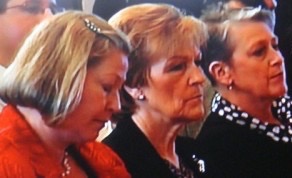One of the Norwegians charged with awarding the Nobel Peace Prize every year is actively opposing the proposed establishment of a large residential facility for asylum seekers in her neighbourhood. Inger-Marie Ytterhorn, a member of the Norwegian Nobel Committee, denied her opposition is at odds with the spirit of the Peace Prize.

“Oh dear you,” replied Ytterhorn, using a Norwegian expression of exasperation when questioned by a reporter from newspaper Dagens Næringsliv (DN). “We shall help where we can.” She went on to claim, however that “it’s not good help to take in more (asylum seekers) … to just cram them together in a camp in Norway.”
Ytterhorn tried to fend off any suggestion that she was resorting to the “not in my backyard” syndrome. Writing in a locally oriented blog called Vestre Aker Posten, she rather feared disturbances to a nearby cemetery and the consequences for the local neighbourhood with so many “new Norwegians” moving in. “Such a heavy new burden on a neighbourhood like this is both misplaced and without any thought to the consequences,” she wrote.
Consequences imposed by her own party
Ytterhorn is a veteran of Norway’s conservative Progress Party, which shares state government power with the Conservatives. Their minority coalition, with the backing of two so-called “support parties” in Parliament, has taken steps to stem the influx of refugees into Norway but remains charged with accommodating the roughly 30,000 new asylum seekers who already have arrived. State immigration agency UDI is now all but ordering local communities to take them in.
The City of Oslo has been told to find housing for 3,000 asylum seekers, in addition to the 2,000 already sitting in temporary reception centers. Newspaper Aftenposten reported last week that among the sites under consideration is an open field called Voksenjordet that’s surrounded by residential areas, the Bogstad Campground and the Bogstad Golf Course north of Røa, where Ytterhorn lives. It’s currently zoned for future expansion of the nearby cemetery.
Ytterhorn was also recently voted in as a local politician for the Oslo district of Vestre Aker, which encompasses Røa and the Bogstad areas. Ytterhorn is now using her clout as a politician to firmly oppose the state’s placement of the asylum center in her district, and the city’s failure to block it. Like many other local potential neighbours to an asylum center with at least 1,000 residents, she thinks the local community should have been consulted and given an opportunity to express their opinions.
“It is extremely undemocratic that local politicians have not been involved,” Ytterhorn told DN on Wednesday. “We are positive towards taking in asylum seekers, but we believe in smaller groups.” She also noted that the Oslo chapter of the Progress Party has put forth a measure in the Oslo City Council to prevent the city from taking in another single asylum seeker until the 2,000 already waiting in reception centers are settled. “We have to solve that problem first, before we take on more,” Ytterhorn said.
Rejects any Nobel conflict
Ytterhorn insisted her opposition to the asylum center does not conflict with her position as a member of the Norwegian Nobel Committee for the past 15 years, with a term that now extends until 2017. She noted how her party has consistently advocated helping refugees by sending aid to countries close to those they’re fleeing.
The challenge now is that thousands or asylum seekers have now made it to Norway and must be accommodated while their asylum applications are being processed. That can take up to two years, and state officials have been scrambling to, as UDI director Frode Forfang has said, “get a roof over their heads.”
Geir Lippestad, the well-known defense attorney who now serves as a top city official for the Labour Party in charge of diversity and integration, has said he “understands that people are worried” about large asylum centers being placed in their neighbourhoods. He notes, however, that it’s a government including Ytterhorn’s own party that has “asked” communities to help accommodate the asylum seekers. In order to try to have some say in where new asylum centers might be located, Lippestad said the city offered three sites including Voksenjordet. UDI (Utlendingsdirektoratet) determined that the other two were deemed unsuitable, leaving the site in Ytterhorn’s district as most likely.
Lippestad stressed that no final decision has been taken and said the city would try to put a limit of 1,000 asylum seekers on the residential facility. Oslo officials, along with many others around the country, object to the state’s plans to house as many as 3,000 asylum seekers all in one place.
“We won’t accept 3,000 in one place,” Lippestad claimed, while acknowledging that UDI needs large facilities because of their inherent economies of scale. He claimed the city otherwise has little control over the process and that it can move quickly once the state makes its decision. The state has been exempted from the usually lengthy process of applying for rezoning and building permits and warning neighbours because of the urgent need for refugee housing.
newsinenglish.no/Nina Berglund

